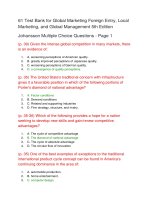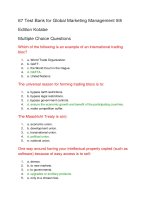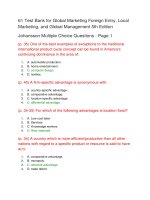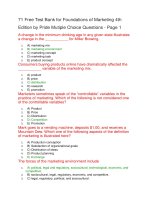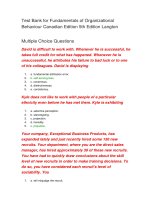121 test bank for global business today 4th canadian edition
Bạn đang xem bản rút gọn của tài liệu. Xem và tải ngay bản đầy đủ của tài liệu tại đây (146.68 KB, 25 trang )
Test Bank for Global Business Today 4th Canadian
Edition
29 Test Bank True – False Questions
7 Test Free Text Questions
85 Test Bank Multiple Choice Questions
The _______ is seen as the lender of last resort to nationstates whose economies are in turmoil and currencies
are losing value against those of other nations.
1.
2.
3.
4.
5.
International Monetary Fund
International bank
United Nations
Canada's Export Development Corporation
Bank of Canada
The __________ is a treaty designed to remove barriers to
the free flow of goods, services, and capital between
nations.
1.
2.
3.
4.
5.
Global Agreement on Tariffs and Commerce
United Nations Treaty on Trade
General Agreement on Tariffs and Trade
Multi-National Agreement on Tariffs and Commerce
The ILO
_______ are the two macro factors that seem to underlie the
trend toward greater globalization.
1.
2.
3.
4.
5.
The increase in global economic stability, and the slowdown in technological
change
The increase in barriers to the free flow of goods, services, and capital that has
occurred since the end of World War II, and global economic stability
The decline in barriers to the free flow of goods, services, and capital that has
occurred in the past 10 years, and the slowdown in technological change
The decline in barriers to the free flow of goods, services, and capital that has
occurred since the end of World War II, and technological change
Technological Change and the convergence of global product preferences
The _______ was created in 1944 by 44 nations that met in
Breton Woods, New Hampshire.
1.
International bank
2.
3.
4.
5.
World Monetary Fund
World Trade Organization
International Monetary Fund
United Nations
Evidence suggests that FDI is playing a(n):
1.
2.
decreasing role in the world economy
increasing role in the world economy for services but a decreasing role in the
world economy for manufactured goods
3. increasing role in the world economy for manufactured goods but a decreasing
role in the world economy for services
4. increasing role in the world economy
5. a limited role in the world economy
Suppose Petro Canada, an international oil company, had a
complaint about a trade issue. The __________, a
governing body established at the Uruguay Round in
1993 to police the international trading system, is an
organization that Petro Canada could take its
complaint to.
1.
2.
3.
4.
5.
World Trade Organization
International Trade Monitoring Bureau
World Tariff and Trade Agency
International Trade Monitoring Agency
The United Nations
The factors of production include:
1.
2.
3.
4.
5.
information technology
process design
markets
labour
research and development
If the Doha talks are ever completed, the biggest gain will
come from what?
1.
2.
3.
4.
5.
trademarks
agriculture
intellectual property
consumer goods
manufactured goods
Although this organization is perhaps best known for its
peacekeeping role, one of its central mandates is the
promotion of higher standards of living, full
employment, and conditions of economic and social
progress and development. What is it called?
1.
2.
3.
4.
5.
World Bank
GATT
United Nations
Canada's Export Development Corporation
Bank of Canada
The steep drop in world trade occurred when?
1.
2.
3.
4.
5.
1950-1951.
1955-1956.
1995-1996.
2005-2006.
2008-2009.
According to the opening case, the most important reason to
assemble iPhones in China was due to:
1.
2.
3.
4.
5.
lower labour costs in China
foreign exchange rates
consumer preferences for foreign items
the ability to scale production up and down
tariffs and trade barriers
Which of the following statements is consistent with data
from the World Trade Organization?
1.
2.
3.
4.
5.
the volume of world trade has grown faster than the volume of world output since
the 1950s.
the volume of world trade has grown slower than the volume of world output since
the 1950s.
the volume of world trade and the volume of world output have grown at
approximately the same rate since the 1950s.
the volume of world trade and the volume of world output have remained constant
since the 1950s.
the volume of world trade is inversely related to the growth of world output.
According to your text, between 1950 to 2000, as world trade
expanded by 20 times, world output grew by about
_______.
1.
2.
3.
12 percent
1 percent
25 percent
4.
5.
6 ½ times
20 times
According to our textbook, the single most important
technological innovation has been the development of
the __________.
1.
2.
3.
4.
5.
telegraph
microprocessor
ocean container
airplane
telephone
Many of the changes that countries have made pertaining to
foreign direct investment regulations have:
1.
2.
3.
4.
made it harder for foreign companies to enter their markets
made it easier for foreign companies to enter their markets
had no effect on the ease upon which foreign companies can enter their markets
made it easier to foreign producers of raw materials to enter their markets but
more difficult for foreign producers of finished products to enter their markets
5. prevented the expropriation of business assets by a foreign government
In the past decades, many countries, in addition to reducing
trade barriers, have done what?
1.
2.
3.
4.
5.
decreased production
increased wages
removed restrictions to FDI
increased tariffs
joined the United Nations
Since 1992, most of the world's changes to FDI have done
what?
1.
2.
3.
4.
5.
blocked FDI
created a more favourable environment for FDI
had no impact on FDI
decreased production
decreased wealth
The average yearly outflow of FDI increased from about $25
billion in 1975 to a record of _______________ in 2007,
though it has fallen more recently.
1.
2.
3.
4.
5.
$500 billion
$73 billion
$1 trillion
$2 trillion
$11 trillion
According to your textbook, between 1930 and 1990, the cost
of a three-minute phone call between New York and
London fell from $244.65 to $3.32. This decrease can
be mainly contributed to
1.
2.
3.
4.
5.
open communication between governments.
the advent of the microprocessor.
continuing efforts to globalize.
high corporate ethical standards.
the deregulation of the telecommunications industry.
Which of the following refers to the exporting of goods or
services to consumers in another country?
1.
2.
3.
4.
5.
situational commerce
world exchange
international trade
cross-national barter
foreign investment
As of 2014 the number of Internet users around the world
exceeds what?
1.
2.
3.
4.
5.
5 million
100 million
1 billion
3 billion
5 billion
Which of the following is a major cause for lowering the
trade barriers of markets and production?
1.
2.
3.
4.
5.
Technological change
Increased labour mobility
Elastic demand
Corporate greed
Consumer demand
The trend toward a more integrated and interdependent
global economic system that has been in place for
many years is commonly referred to as:
1.
2.
3.
4.
5.
market standardization
cross-border integration
globalization
consumerism
nationalization
The agency established at the 1993 Uruguay Round to police
the international trading system is the __________.
1.
2.
3.
4.
5.
Global Trade Enforcement Administration
World Tariff and Trade Bureau
International Trade Enforcement Agency
World Trade Organization
The European bank of Reconstruction and Development
After World War II, the West committed to removing trade
barriers between nations because of what experience?
1.
2.
3.
4.
5.
the loss of production from the war
retaliatory trade policies leading to the Depression
the General Agreement on Tariffs and Trade
massive waves of immigrants seeking jobs
the shift away from production to consumption
The acronym GATT stands for:
1.
2.
3.
4.
5.
Global Agreement on Taxation and Tariffs
Global Association of Technology and Trade
General Agreement on Taxation and Trademarks
General Agreement on Tariffs and Trade
General Accord of Transportation and Trade
The Web is viewed as a global what?
1.
2.
3.
4.
5.
equalizer
way of decreasing production
force for decreasing FDI
way of reaching businesses at the expense of consumer
way for government to market to its population
Sourcing goods and services from locations around the
globe is known as __________.
1.
2.
3.
4.
5.
melding of markets
integration of markets
deregulation
globalization of production
globalization of markets
Which of the following was not an outcome of the Uruguay
Round of the GATT?
1.
2.
3.
4.
reduced trade barriers
extended GATT to cover services as well as manufactured goods
established the World Trade Organization
provided extended protection for patents, trademarks, and copyrights
5.
reduced agricultural subsidies
Since 1950, world trade has grown faster than what?
1.
2.
3.
4.
5.
world wage rates
world population growth
world income
world output
world housing production
Between 1992 and 2010, the total flow of FDI from all
countries increase by about _______.
1.
2.
3.
4.
5.
2 times
3 times
6 times
7 times
9 times
XYZ, Inc. is an auto parts distributing warehouse that
exports many of its products to consumers in other
countries. XYZ Inc. can be described as engaging in:
1.
2.
3.
4.
5.
international trade.
cross-border investments.
product development.
trading barriers.
international procurement.
Under the umbrella of GATT there have been eight rounds of
negotiations among member states. The _______ was
the most recent round of negotiations.
1.
2.
3.
4.
5.
Uruguay Round
Malaysian Symposium
German Round
New Zealand Symposium
Cancun Round
The acronym WTO stands for:
1.
2.
3.
4.
5.
Western Trade Organization
World Tax Organization
World Trade Organization
World Tariff Organization
World Trade Operations
According to our textbook, e-commerce retail sales are
expected to reach _____ by 2018 in the United states
alone.
1.
2.
3.
4.
5.
$1 billion
$50 billion
$500 billion
$750 billion
$1 trillion
The globalization of __________ refers to the sourcing of
goods and services from locations around the globe to
take advantage of national differences in the cost and
quality of factors of production (such as labour,
energy, land, and capital).
1.
2.
3.
4.
5.
information technology
process design
markets
production
R&D
_______ is the theory that predicts that the number of
transistors on a computer chip doubles every 24
months.
1.
2.
3.
4.
5.
Brennan's Theorem
Bailey's Law
Moore's Law
Ivan's Law
Global Micro Accelerant (GMA) Law
Although Inco is a Canadian company, it has invested
substantial business resources in activities outside
Canada. This practice is referred to as:
1.
2.
3.
4.
5.
transnational commerce
foreign direct investment
international trade
organizational diversification
outsourcing
The globalization of markets, the growth of world trade, and
the increase in FDI has had what effect?
______________.
1.
a decrease in production
2.
3.
4.
5.
a decrease in world trade
companies find their home markets under attack from foreign competitors
companies are reducing their profits
companies are during to protectionist measures
What was created at the same time as the International
Monetary Fund?
1.
2.
3.
4.
5.
World Bank
GATT
United Nations
Canada's Export Development Corporation
Bank of Canada
The investing of resources in business activities outside a
firm's home country is referred to as:
1.
2.
3.
4.
5.
international trade
domestic direct investment
transnational barter
foreign direct investment
outsourcing
According to our textbook, the growing integration of the
world economy is:
1.
2.
3.
4.
5.
increasing the intensity of competition within the home market of a company in a
wide range of manufacturing and service industries
decreasing the intensity of global competition in manufacturing industries, and
increasing the intensity of domestic competition in services
increasing the intensity of global competition in manufacturing industries, and
decreasing the intensity of domestic competition in services
narrowing the scope of global competition in a wide range of service, commodity,
and manufacturing industries
Widening the opportunities for competing with manufacturing companies within
their home market and narrowing the opportunities for competing with service
companies in their home market.
Firm X exports a number of products to users in other
countries. This practice is referred to as __________.
1.
2.
3.
4.
5.
world exchange
international trade
cross-national barter
situational commerce
multinational diversification
Who is responsible for policing the world trading system?
1.
2.
International Monetary Fund
The World Bank
3.
4.
5.
The World Trade Organization
Canada's Export Development Corporation
Bank of Canada
85 Free Test Bank for Global Business Today 4th
Canadian Edition by Hill Multiple Choice
Questions - Page 2
If we look into the future, most forecasts now predict a
__________ in world output accounted for by
developing nations such as China, India, Indonesia,
and South Korea, and a __________ in the share
enjoyed by rich industrialized countries such as
Britain, Japan, and the United States.
1.
2.
3.
4.
5.
rapid rise; rapid decline
slight rise; slight decline
rapid decline; rapid rise
rapid rise; slight decline
stay the same; slight decline
The economies of most of the former Communist countries
can best be described as:
1.
2.
3.
4.
5.
in poor condition with high risk associated with doing business there
steady growth, especially since 2009
dominated by multinationals
robust and growing stronger
closed to many international businesses due to high tariffs
Managing an international business is different from
managing a purely domestic business for all of the
following reasons except:
1.
2.
3.
countries are different
international transactions involve converting money into different currencies
the range of problems confronted by a manager in an international business are
narrower than those confronted by a manager in a domestic business
4. an international business must find ways to work within the limits imposed by
government intervention in the international trade and investment system
5. different languages have to be learned
Supranational organizations such as the WTO are criticized
for
1.
2.
interfering in the regulation of prices of a country's natural resources.
ruling in favour of rich western countries at the expense of poor developing
countries.
3.
4.
5.
focusing on economics and not on democracy and environmental responsibility.
limiting its actions to what the WTO member states agree to.
encouraging economic stagnation in poor countries so that rich countries can grow
faster.
Due to containerization, the transportation costs associated
with the globalization of production have:
1.
2.
3.
4.
5.
remained the same
increased dramatically
declined
increased slightly
reduced insurance costs
In recent years, all of the following countries have seen their
relative share of world output fall except:
1.
2.
3.
4.
5.
United States
France
Germany
China
United Kingdom
What does NAFTA stand for?
1.
2.
3.
4.
5.
North American Free Trade Agreement
North Atlantic Free Trade Agency
North American Federation of Trade Advocates
National Alliance for Technology Advancement
North American Federal Treaty Association
Iceculture Inc., of Ontario employs 40 people and exports
around the world. It would be considered
1.
2.
3.
4.
5.
a multinational company.
a transnational company.
a cross-border national company.
a mini-multinational.
a U.S. dominated company.
Recently there has been _______ in the number of smaller
firms that are multinationals.
1.
2.
3.
4.
5.
a significant growth
no change
a significant decline
some growth
some decline
One frequently voiced concern about globalization is that it
destroys manufacturing jobs in wealthy advanced
economies such as Canada. The basic thrust of the
critics' argument is:
1.
2.
3.
4.
5.
developing nations will recruit employees from the more advanced economies,
thereby depleting their labour pools
globalization increases the pace of the shift from a world economy based on
manufactured goods to a world economy based on services
falling trade barriers allows firms to move their manufacturing activities offshore to
countries where wage rates are much lower
the governments of developing countries will heavily subsidize their primary
industries, making competing products produced in advanced
economies less attractive Canadian workers are overpaid and the true value of a
manufacturing job is much lower
_______ is not a benefit of globalization.
1.
2.
3.
4.
5.
Lowering prices for goods
Raising the incomes of consumers
Slowing economic growth
Helping to create jobs in all countries that choose to participate
More leisure time
In 2013, the U.S.'s largest trade partner when it comes to
exports from the United States was
___________________.
1.
2.
3.
4.
5.
United Kingdom
Mexico
China
Canada
South Korea
Although the characteristics of the global economy have
changed dramatically over the past 50 years, as late as
the 1960s all of the following demographic
characteristics were true except:
1.
2.
3.
4.
5.
the U.S. dominated the world economy
small, U.S. entrepreneurial firms dominated the international business scene
the U.S. dominated the world foreign direct investment picture
the U.S. was the world's largest industrial power
the U.S. dominated world trade
The relative decline of the developed countries' share of
world output _________________.
1.
will reduce the living standards of the citizens of developed countries.
2.
3.
4.
5.
will increase competition for scarce resources and create political instability.
reflects the growing economic and industrial strength of developing countries.
will decrease prices but also reduce wages in Canada
will decrease job opportunities in Canada
As a result of a variety of innovations, the real costs of
information processing and communication have
__________ over the past two decades.
1.
2.
3.
4.
5.
fallen slightly
increased slightly
remained constant
fallen dramatically
had no impact on the cost of international business
_______ was not mentioned in our textbook as major
innovation in transportation technology.
1.
2.
3.
4.
5.
Commercial jet aircraft
Super freighters
E-commerce
The introduction of containerization
Both containerization and e-commerce were not mentioned
The foreign direct investment by non-U.S. firms was
motivated primarily by the following two factors:
1.
2.
3.
4.
5.
the desire to disperse production activities to optimal locations; and the desire to
build a direct presence in major foreign markets
the desire to disperse production activities to optimal locations; and the desire to
influence foreign exchange rates
the desire to influence foreign exchange rates; and the desire to influence political
developments in foreign countries
the desire to build a direct presence in major foreign markets; and the desire to
influence political developments in foreign countries
the desire to reduce dependence on the United States and to increase direct
access to markets
If China continues to grow at its current rate, by 2020 the
average income per capita will be about $13,000,
roughly equivalent to what country today?
1.
2.
3.
4.
5.
Canada
United States
Spain
India
Latin America
Economists argue that increased international trade and
cross-border investments will result in __________
prices for goods and services.
1.
2.
3.
4.
5.
higher
stable
lower
unstable
variable
Which of the following statements is not true regarding the
majority of Latin American countries?
1.
2.
3.
4.
5.
governments are selling state-owned enterprises to private investors
foreign investment is welcome
debt and inflation are down
neither democracy nor free market reforms have seemed to take hold
None of these answers is correct
Which of the following is an example of a developing
nation?
1.
2.
3.
4.
5.
Thailand
Britain
Japan
United States
Canada
According to your text, the World Bank estimates that
today's developing nations may account for more than
_______ percent of world economic activity by 2020.
1.
2.
3.
4.
5.
35
50
55
65
60
Disturbing signs of growing unrest and totalitarian
tendencies continue to be seen in many _______
states.
1.
2.
3.
4.
5.
Western European
European
Northern European
Eastern European
South American states
Which country was the world's most dominant industry
power was in the early 1960s?
1.
2.
3.
4.
5.
Japan
The United Kingdom
Germany
The United States
Canada
What kind of enterprise is a business that has productive
activities in two or more countries?
1.
2.
3.
4.
5.
cross-cultural
multinational
varied-national
diverse-national
multi-domestic
Since the 1960s, what has been a notable trend regarding
multinational enterprises?
1.
2.
3.
4.
5.
the decline of the multinational enterprise
the decline of the Canadian multinational enterprise
the rise of non-U.S. multinationals
the decline of the Japanese multinational enterprise
the rise of U.S. multinationals
Many critics of globalization argue that outsourcing leads to
increased use of _________ labour practices in
developing countries.
1.
2.
3.
4.
5.
exploitive
fair
underground
neo-colonialist
non-competitive
The Tim Hortons case study is an example of what?
1.
2.
3.
4.
5.
how easily Canadian firms can enter the US market
the similarity of Canadian and US consumer tastes
Canadian firms buying up US firms
protests against globalization
the difficulty of Canadian firms expanding internationally
In 1960, the U.S. accounted for about _____ of world output
as measured by GDP.
1.
2.
10.0%
23.0%
3.
4.
5.
30.0%
38.3%
54.0%
Throughout the 1990s, the amount of investment directed at
both developed and developing nations did what?
1.
2.
3.
4.
5.
stayed the same
decreased
increased
was highly variable
decreased, then increased
Among developing nations, the largest recipient of foreign
direct investment has been which country?
1.
2.
3.
4.
5.
China
India
Japan
Canada
the United States
What is the primary purpose of the World Trade
Organization?
1.
2.
3.
4.
5.
arbitrate of trade disputes act as a "watchdog" for countries that lower their
pollution standards in
an effort to attract more foreign manufacturing activity
set tariffs for countries that signed the GATT agreement
monitor the implementation of trade agreements such as NAFTA
reduce the number of job losses in member countries
Since the 1960s, there have been two notable trends in the
demographics of the multinational enterprise. These
two trends have been:
1.
2.
3.
4.
5.
the rise of non-U.S. multinationals and the disappearance of mini-multinationals
the decline of non-U.S. multinationals and the decline of mini-multinationals
the decline of non-U.S. multinationals and the growth of mini-multinationals
the rise of non-U.S. multinationals and the growth of mini-multinationals
the rise of U.S. multinationals and the growth of mini-multinationals
Outsourcing has even extended to the Canadian _______
industry.
1.
2.
3.
4.
5.
auto
mineral extraction
services
home construction
lumber
General Electric Corporation has productive activities in a
number of countries. As a result, it would be
appropriate to refer to General Electric as a
__________
1.
2.
3.
4.
5.
corporation.
transnational
diverse-national
cross-national
multinational global
The last quarter of the 20th century experienced __________
in the global economy.
1.
2.
3.
4.
5.
increased stability
slow-moving
virtually no changes
rapid changes
great concerns over potential disruptions
Critics use the following argument to suggest that
globalization is a contributing factor to an increase in
pollution.
1.
2.
3.
4.
5.
globalization results in an increase in the amount of activity that takes place in
companies that do not have adequate pollution controls
globalization results in increased commerce between countries, which results in
an increase in the amount of transportation activity (e.g. trains, barges, air cargo,
trucks, etc.)
firms that operate in countries that have adequate pollution regulations have a
tendency to move their manufacturing operations to countries that have less
stringent or no pollution controls to avoid the cost of regulation
globalization results in increased production, which has the undesirable side-effect
of increased pollution
people in developing countries are used to coping with more pollution
The world's poorest nations have also faced __________.
1.
2.
3.
4.
5.
standardization
alignment
global simplification
economic stagnation
consumerization
_______ is not considered to be a "developing" nation.
1.
2.
3.
4.
Brazil
India
China
Japan
5.
Mexico
In the 1960s, what was then seen as an economic threat to
Europe?
1.
2.
3.
4.
5.
The dominance of U.S. firms
Technological innovations
Low-cost transportation
Low-cost global communication networks
Reduction in trade barriers
Economists, politicians, and business leaders believe that
the _______ to international trade and investment is
the engine driving the global economy toward
1.
2.
3.
4.
5.
greater prosperity.
falling barriers cross-border investments
U.N. policies
trading barriers
NAFTA
29 Free Test Bank for Global Business Today 4th
Canadian Edition by Hill True - False Questions
Sourcing goods and services from locations around the
globe is known as the globalization of markets.
1.
2.
True
False
To benefit from the globalization of markets, a company has
to be a multinational firm.
1.
2.
True
False
In addition to reducing trade barriers, many countries have
also been progressively removing restrictions on
barriers to foreign direct investment.
1.
2.
True
False
Although most international trade and investment is still
conducted by large firms, small to medium sized firms
are increasingly involved in international trade and
investment.
1.
2.
True
False
The International Monetary Fund and the World Bank were
both created in 1944 by 44 nations that met at Bretton
Woods, New Hampshire.
1.
2.
True
False
Economists argue that increased international trade and
cross-border investments will result in higher prices
for goods and services, although there are many
benefits to globalization.
1.
2.
True
False
Many of tomorrow's economic opportunities may be found in
the developing nations of the world.
1.
2.
True
False
There is very little evidence that suggests that the lowering
of trade barriers has facilitated the globalization of
production.
1.
2.
True
False
The financial crisis in Thailand shows one of the risks of
globalization.
1.
2.
True
False
The International Monetary Fund (IMF) is often seen as the
leader of last resort to nation states whose economies
are in economic turmoil.
1.
2.
True
False
If what is occurring in China continues for two more
decades, China may move from third-world to
industrial superpower status even more rapidly than
Japan did.
1.
2.
True
False
Currently most global markets are markets for consumer
goods.
1.
2.
True
False
An MNE is any firm that invests outside of its home country.
1.
2.
True
False
In the 1960s global business activity was dominated by large
Japanese multinational corporations.
1.
2.
True
False
The volume of goods, services and investment crossing
national borders expanded faster than did world
output every year during the last two decades of the
20th century.
1.
2.
True
False
Between 1995 and 2000 most countries in Eastern Europe
saw their Communist governments collapse.
1.
2.
True
False
The global economy is moving progressively towards a
world in which national economies are relatively
isolated from each other.
1.
2.
True
False
The advanced nations of the East committed themselves
after World War II to removing barriers to the free flow
of goods, services, and capital between nations.
1.
2.
True
False
Surprisingly, despite the importance of technology in our
everyday lives, technological change has played only a
minor role in the globalization of markets.
1.
True
2.
False
Some Canadian firms have outsourced jobs to developing
countries.
1.
2.
True
False
Although many companies have lowered their overall cost
structure and have improved the quality of their
products by dispersing their production activities to
locations around the world, this activity is confined
primarily to large firms.
1.
2.
True
False
Currently most global markets are for industrial goods and
materials that serve a universal need the world over.
1.
2.
True
False
Currently most global markets are markets for consumer
goods.
1.
2.
True
False
As markets globalize and an increasing proportion of
business activity transcends national borders, there is
a need for institutions to help manage, regulate and
police the global market place.
1.
2.
True
False
The volume of world output has grown faster than the
volume of world trade since the 1950s, according to
data from the World Trade Organization.
1.
2.
True
False
Because of the global presence of widely accepted products
like McDonalds, Coca-Cola, and Apple's iPod, national
markets are disappearing.
1.
2.
True
False
Most forecasts now predict a rapid rise in world output
accounted for by developing nations such as China,
India, and South Korea, and a rapid decline in the
share enjoyed by rich industrialized countries such as
Canada, Britain and the United States.
1.
2.
True
False
It is commonly believed that globalization stimulates
economic growth, creates jobs, and raises income
levels.
1.
2.
True
False
General Agreement on Tariffs and Trade is what the acronym
GATT stands for.
1.
2.
True
False
7 Free Test Bank for Global Business Today 4th
Canadian Edition by Hill Free Text Questions
Describe the two main facets of globalization. Explain how
each of these components of globalization has helped
create the shift towards a more integrated world
economy.
Answer Given
The two main components of globalization are the globalization of markets and the
globalization of production. The globalization of markets refers to the fact that in
many industries historically distinct and separate national markets are merging
into one huge global marketplace. The globalization of production refers to the
tendency among many firms to source goods and services from different locations
around the world in an attempt to take advantage of national differences in the
cost and quality of factors of production (such as labour, energy, and capital). Both
of these components of globalization have helped create the shift towards a more
integrated world economy. The globalization of markets has created a "global"
interest in many products, such as Coca-Cola, the Apple iPhones, and Levi jeans.
This "sharing of interest" in products across national borders has facilitated the
trend towards a more integrated world economy. The globalization of production
has resulted in a substantial increase in the number of business relationships
between companies from different countries. This increase in the number and
intensity of interrelationships between companies from different countries has also
facilitated the trend towards a more integrated world economy.
Describe the impact of the development of the World Wide
Web on global commerce.
Answer Given
Viewed globally, the Web is emerging as the great equalizer. There is no
geography on the Web and costs to provide extensive information and product
offerings are low when compared to other more traditional means of doing
business. It is a powerful dislocating force that rolls back some constraints of
location, scale, and time zones. The Web allows businesses, both small and large,
to expand their global presence at a lower cost than ever before.
Describe the concept of globalization. What are the major
opportunities and challenges that globalization has
created for business organization?
Answer Given
Globalization refers to a fundamental shift that is occurring in the world economy.
The world is progressively moving away from a structure in which national
economies are relatively isolated from each other, towards a structure in which
national economies are merging into one huge interdependent global economic
system. This trend is commonly referred to as globalization. The trend towards
globalization is creating many opportunities for businesses to expand their
revenues, drive down their costs, and boost their profits. For example, many
Canadian firms are now exporting to previously closed foreign markets. By doing
so, these firms are simultaneously expanding their sales and driving down their
costs through additional economies of scale. Globalization has also created
challenges for business organizations. For example, managers now have to
grapple with a wide range of globalization related issues. Examples of these
issues include: should we export, should we build a plant in a foreign country,
should we modify our products to suite the tastes of each of our foreign
customers, and how do we respond to foreign competition? These questions often
do not have easy answers, but are very important to the future competitiveness of
business organizations.
Describe the meaning of the term "trade barriers"? What
measures have been taken by the world community to
reduce the impact of trade barriers on international
trade?
Answer Given
Trade barriers are the regulations, tariffs, and other activities that are put in place
by governments for the purpose of protecting their domestic industries from
"foreign competition." For example, a country may impose a stiff tariff on the
import of foreign produced automobiles. That makes it very difficult (i.e., creates a
substantial barrier) for foreign produced cars to be sold in their country. The world
community has taken a number of measures to not only lessen the impact of trade
barriers on international trade, but to remove trade barriers altogether. The
General Agreement on Tariffs and Trade (GATT) has been an ongoing effort to
remove and reduce trade barriers worldwide. Under the umbrella of GATT, there
have been eight rounds of negotiations among member states, designed to lower
and/or reduce all forms of trade barriers. To provide the GATT treaty some teeth,
the recently completed Uruguay Round of GATT established the World Trade
Organization (WTO) which polices the international trading system. Although the
WTO cannot compel a nation to comply with the GATT treaty, it can recommend
that other member nations impose sanctions on the offending party. Other
business organizations, governments, trade groups, and not-for-profit
organizations are working hard to reduce and remove trade barriers. The Doha
and Cancun rounds have focused on the question of agricultural subsidies used
by developed countries to support their farmers. These agricultural subsidies have
made it almost impossible for developing country farmers to compete.
Define the term "foreign direct investment (FDI)." How does
the term "foreign direct investment" differ from the
term "international trade?"
Answer Given
Foreign direct investment occurs when a firm invests resources in business
activities outside its home country. For example, a Canadian firm may invest in a
production facility in Italy. International trade occurs when a firm exports goods or
services to consumers in another country. The difference between the terms is that
the term "international trade" does not necessarily mean that a firm is investing
resources in business activities outside its home country the firm could be simply
exporting domestically produced products to a foreign country.
Why is international trade important to Canada?
Answer Given
Canada's exports contribute about 40% of our GDP. We have a trade surplus
overall meaning we are exporting more than we are importing. Many jobs and FDI
are dependent upon international trade. Canada needs international trade in order
to maintain its standard of living. However, Canada's standard of living has been
decreasing relative to the United States and unless Canada begins to increase
their productivity and international sales, the standard of living will continue to
decrease.
Discuss the primary advantages and disadvantages of
globalization. Do you believe the advantages outweigh
the disadvantages? How can the effects of the
disadvantages of globalization be reduced?
Answer Given
There are many advantages of globalization. From a broad perspective,
globalization creates economic activity (which stimulates economic growth),
creates jobs, raises income levels, and provides consumers with more choices in
regard to the products and services that are available to them. From the
perspective of an individual firm, globalization has the potential to increase
revenues (through expanded market potential), drive down costs (through
additional economies of scale), and boost profits. Conversely, critics argue that
globalization destroys manufacturing jobs in wealthy countries and contributes to
pollution. In regard to destroying manufacturing jobs, the basic thrust of the critics'
argument is that falling trade barriers allow firms in industrialized countries to
move their manufacturing activities offshore to countries where wage rates are
much lower. This activity, if it occurs, has the undesirable side-effect of eliminating
manufacturing jobs in the industrialized country. In regard to pollution, the critics of
globalization argue that globalization encourages firms from advanced nations to
move manufacturing facilities offshore to less developed countries to avoid the
more stringent pollution controls in place in their home countries. This activity
increases worldwide pollution. The final section of the question is designed to
encourage classroom discussion and/or to encourage students to "
